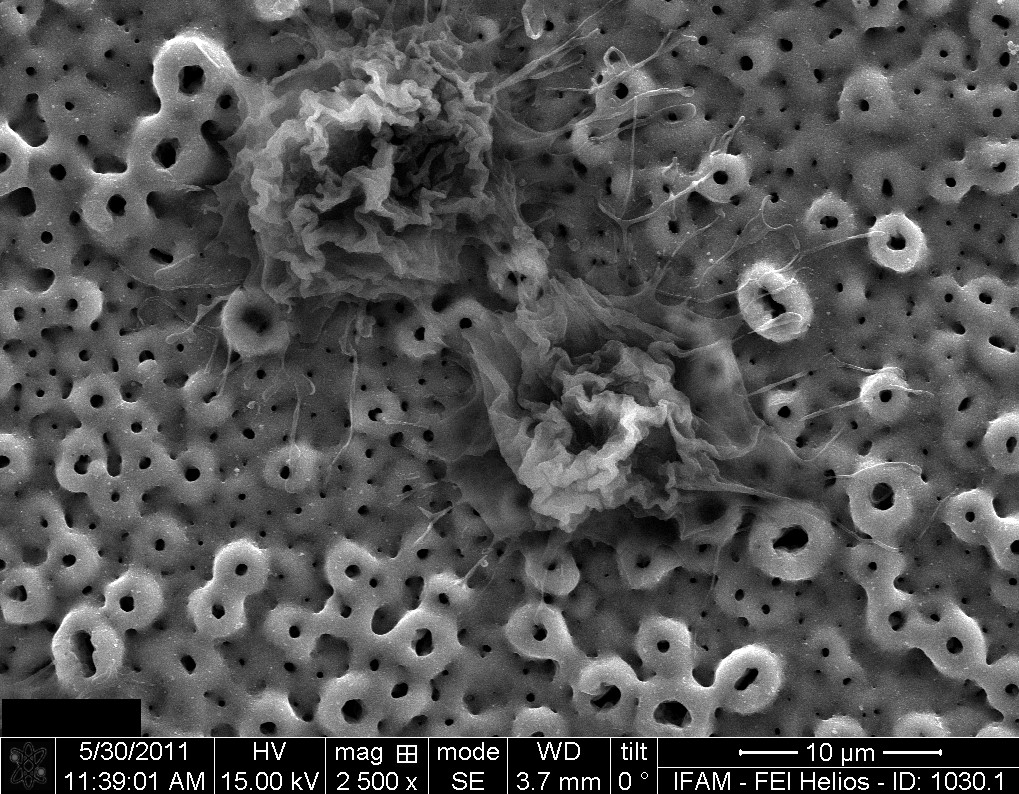Quality assurance and galvanic customer solutions for implant materials
Many properties of implant materials, e.g. biocompatibility, cell adhesion, wetting behavior and corrosion, depend to a large extent on the chemical and morphological structure of the surface. With the aid of quality assurance concepts for the evaluation of surface properties, it is possible to gain detailed knowledge of these; thus, possible damage to health can be avoided. Fraunhofer IFAM provides support in this area and, with its extensive knowledge of surface technology (e.g. also in wet chemistry), can, among other things, create innovative process-oriented development concepts to improve the properties of implant materials.
Surface properties of implants must be analyzed
Extensive quality assurance concepts require the characterization of the surface properties of implant materials. For this purpose, our scientists use a wide range of analytical and imaging techniques. Among other things, it is necessary to obtain detailed information about the elemental and molecular composition of the surface, e.g. by means of:
- Photoelectron spectroscopy (XPS)
- Auger electron spectroscopy (AES)
- Time-of-flight secondary ion mass spectrometry (TOF-SIMS)
Imaging techniques can be used to visualize topographic and morphological structures of the surface at various scales down to molecular scales:
- Optical microscope
- Scanning electron microscope (SEM with FIB option)
- Atomic force microscope (AFM)
- Transmission electron microscope (TEM)
Galvanic customer solutions for successful surface pre-treatment
Our experts develop customized solutions, taking into account our own market and literature research on the state of the art as well as the selection and optimization of suitable pre-treatment and coating processes to improve the surface properties of implant materials. We also optimize existing surface treatment processes. Among other things, we also take into account possible strategies for cost reduction and time saving and can provide the best possible support through extensive in-process analytics.
Especially wet chemistry (galvanic technology) still plays a key role in surface pre-treatment, also for medical devices. In addition, wet chemistry has a decisive advantage over mechanical or physical methods in the pre-treatment of metals such as titanium, magnesium, stainless steel or aluminum, which can be relevant for some processes. Wet chemistry can also be used to pre-treat or modify areas that cannot be reached by methods using laser or plasma technology (e.g. implants with complex geometries).
Therefore, one of the most important steps for companies in the field of surface pre-treatment is to use wet chemistry processes and products. Fraunhofer IFAM also provides support here with the development and optimization of galvanic processes.
REACh regulation and HSE guidelines: "Green" chemistry with less substances hazardous to the environment and health
Even today, and in the coming years, many companies will also have to make significant changes in medical technology, as various chemicals may no longer be used or may only be used to a limited extent. Fraunhofer IFAM is already familiar with the needs of customers from various bilateral partnerships and can therefore also include the sustainability aspect in the development of processes and products. In doing so, we take into account the use of substances which are less hazardous to the environment and health and comply with EU-wide REACh as well as general HSE principles.
Thanks to their highly networked activities in the field of surface technology, our scientists from the Adhesion and Interface Research department are also skilled at developing alternative ideas and strategies, such as the use of anti-wear coatings as disinfecting surfaces or the application of coatings for wear protection in medical technology.
 Fraunhofer Institute for Manufacturing Technology and Advanced Materials IFAM
Fraunhofer Institute for Manufacturing Technology and Advanced Materials IFAM